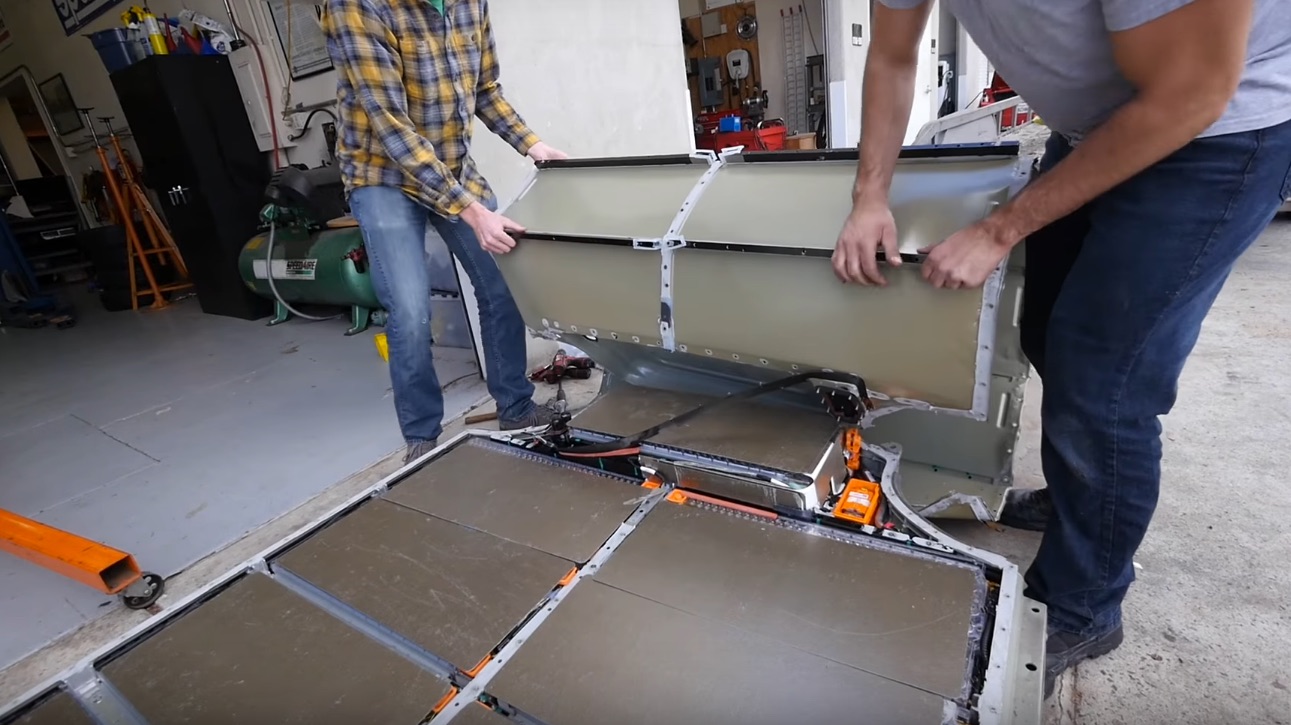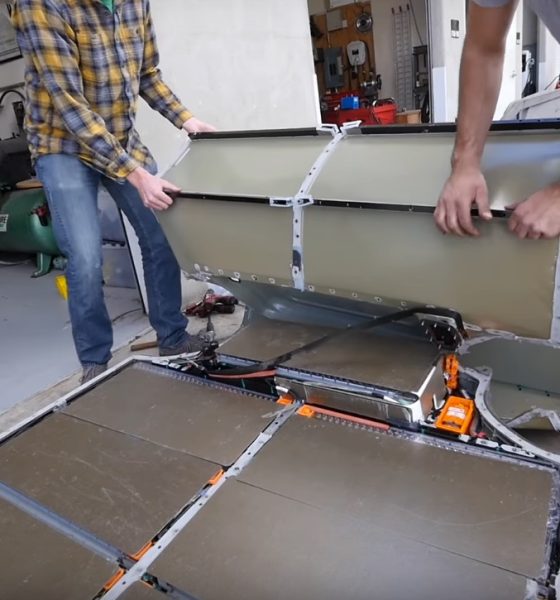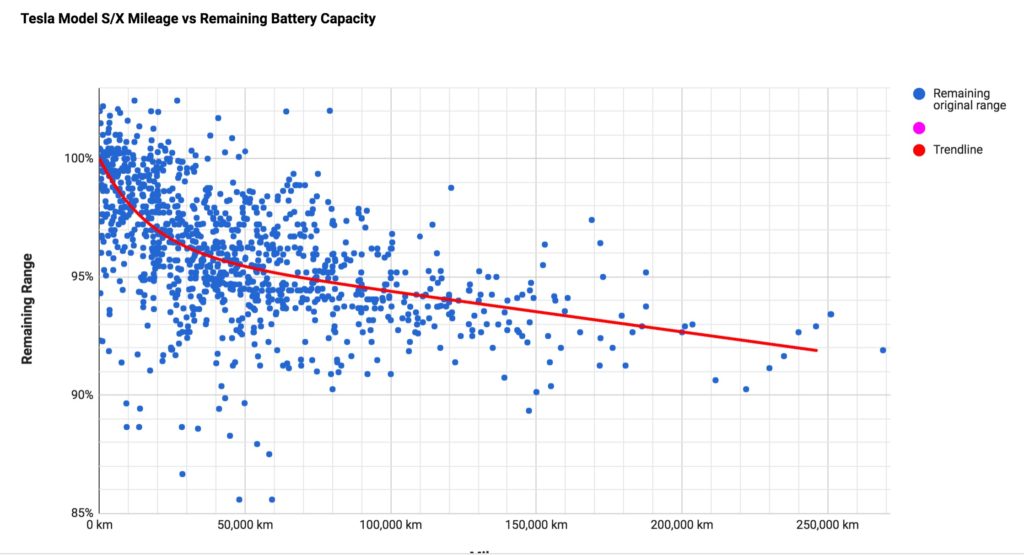

News
Tesla battery predicted to have 80% capacity after 840,000 km (521,000 mi)
An updated battery study based on crowdsourced data from Model S and Model X owners suggests that Tesla’s battery pack will still have 80% capacity after reaching 840,000 kilometers (521,952 miles), or nearly 1 million kilometers driven.
An online spreadsheet created by Matteo and maintained by Merijn Coumans via the Dutch-Belgium Tesla Forum tracks battery degradation being experienced by roughly 900 Tesla drivers from around the world. Using a linear progression model, the spreadsheet compiles various data points to create a trend line that suggests remaining battery capacity for a Tesla Model S and Model X over its lifetime.
This information is important to many Tesla owners and would-be buyers as it provides insight to expected driving range a vehicle could have (per single charge) over time.

Tesla Model S and Model X battery degradation chart [Credit: Matteo via Maarten Steinbuch]
The trend line seen in the chart has a slope of 60,000 km (40,000 miles) per 1 percent of 50,000 km (30,000 miles), meaning that on average the battery will degrade by 1 percent every 50,000 km driven. According to Maarten Steinbuch’s blog post, a Tesla Model S or Model X will still retain 92% of its battery capacity at 240,000 km (150,00 miles). By comparison, an internal combustion engine vehicle is expected to reach its end of life at around 220,000 km (140,000 miles).
Data revealed in the crowdsourced battery survey follows suit with recent reports that a Finnish taxi driver who crossed the 400,000 km (250,000 mile) mark in his Tesla Model S experienced only 7 percent degradation.
In addition, Tesloop, a city-to-city Tesla shuttle service available in Southern California, had its first vehicle reach the 483,000 kilometer (300,000 mile) mark with only $11,000 in vehicle maintenance costs.
“Over the last two years, we have seen that that electric, supercharged vehicles can be deployed at utilization levels unheard of with gas vehicles,” Tesloop said in a statement. “And while saving over $60,000 on fuel and maintenance is a substantial economic win, we feel the bigger win is that this car is ready for another 900,000 miles over the next 6 years under its current warranty.”
It’s worth noting that the battery degradation data we’re seeing is from Tesla’s 18650 cell and not the company’s newest 2170 cell being used on the Model 3. Based on Tesla’s comment that its 2170 cell has improved energy density and an all-around more efficient design, it wouldn’t come as a surprise if Model 3 and future fleet’s using this cell type can support more battery cycles, reach 1 million miles of use, and still retain over 80% of its original capacity.
Based on these drivers’ stories, and battery data being compiled by Tesla drivers from around the world, it seems clear that a Tesla has quadruple the lifespan of any ICE car, and can outlast it by nearly ten-fold.

News
Nvidia CEO Jensen Huang explains difference between Tesla FSD and Alpamayo
“Tesla’s FSD stack is completely world-class,” the Nvidia CEO said.

NVIDIA CEO Jensen Huang has offered high praise for Tesla’s Full Self-Driving (FSD) system during a Q&A at CES 2026, calling it “world-class” and “state-of-the-art” in design, training, and performance.
More importantly, he also shared some insights about the key differences between FSD and Nvidia’s recently announced Alpamayo system.
Jensen Huang’s praise for Tesla FSD
Nvidia made headlines at CES following its announcement of Alpamayo, which uses artificial intelligence to accelerate the development of autonomous driving solutions. Due to its focus on AI, many started speculating that Alpamayo would be a direct rival to FSD. This was somewhat addressed by Elon Musk, who predicted that “they will find that it’s easy to get to 99% and then super hard to solve the long tail of the distribution.”
During his Q&A, Nvidia CEO Jensen Huang was asked about the difference between FSD and Alpamayo. His response was extensive:
“Tesla’s FSD stack is completely world-class. They’ve been working on it for quite some time. It’s world-class not only in the number of miles it’s accumulated, but in the way it’s designed, the way they do training, data collection, curation, synthetic data generation, and all of their simulation technologies.
“Of course, the latest generation is end-to-end Full Self-Driving—meaning it’s one large model trained end to end. And so… Elon’s AD system is, in every way, 100% state-of-the-art. I’m really quite impressed by the technology. I have it, and I drive it in our house, and it works incredibly well,” the Nvidia CEO said.
Nvidia’s platform approach vs Tesla’s integration
Huang also stated that Nvidia’s Alpamayo system was built around a fundamentally different philosophy from Tesla’s. Rather than developing self-driving cars itself, Nvidia supplies the full autonomous technology stack for other companies to use.
“Nvidia doesn’t build self-driving cars. We build the full stack so others can,” Huang said, explaining that Nvidia provides separate systems for training, simulation, and in-vehicle computing, all supported by shared software.
He added that customers can adopt as much or as little of the platform as they need, noting that Nvidia works across the industry, including with Tesla on training systems and companies like Waymo, XPeng, and Nuro on vehicle computing.
“So our system is really quite pervasive because we’re a technology platform provider. That’s the primary difference. There’s no question in our mind that, of the billion cars on the road today, in another 10 years’ time, hundreds of millions of them will have great autonomous capability. This is likely one of the largest, fastest-growing technology industries over the next decade.”
He also emphasized Nvidia’s open approach, saying the company open-sources its models and helps partners train their own systems. “We’re not a self-driving car company. We’re enabling the autonomous industry,” Huang said.
Elon Musk
Elon Musk confirms xAI’s purchase of five 380 MW natural gas turbines
The deal, which was confirmed by Musk on X, highlights xAI’s effort to aggressively scale its operations.

xAI, Elon Musk’s artificial intelligence startup, has purchased five additional 380 MW natural gas turbines from South Korea’s Doosan Enerbility to power its growing supercomputer clusters.
The deal, which was confirmed by Musk on X, highlights xAI’s effort to aggressively scale its operations.
xAI’s turbine deal details
News of xAI’s new turbines was shared on social media platform X, with user @SemiAnalysis_ stating that the turbines were produced by South Korea’s Doosan Enerbility. As noted in an Asian Business Daily report, Doosan Enerbility announced last October that it signed a contract to supply two 380 MW gas turbines for a major U.S. tech company. Doosan later noted in December that it secured an order for three more 380 MW gas turbines.
As per the X user, the gas turbines would power an additional 600,000+ GB200 NVL72 equivalent size cluster. This should make xAI’s facilities among the largest in the world. In a reply, Elon Musk confirmed that xAI did purchase the turbines. “True,” Musk wrote in a post on X.
xAI’s ambitions
Recent reports have indicated that xAI closed an upsized $20 billion Series E funding round, exceeding the initial $15 billion target to fuel rapid infrastructure scaling and AI product development. The funding, as per the AI startup, “will accelerate our world-leading infrastructure buildout, enable the rapid development and deployment of transformative AI products.”
The company also teased the rollout of its upcoming frontier AI model. “Looking ahead, Grok 5 is currently in training, and we are focused on launching innovative new consumer and enterprise products that harness the power of Grok, Colossus, and 𝕏 to transform how we live, work, and play,” xAI wrote in a post on its website.
Elon Musk
Elon Musk’s xAI closes upsized $20B Series E funding round
xAI announced the investment round in a post on its official website.

xAI has closed an upsized $20 billion Series E funding round, exceeding the initial $15 billion target to fuel rapid infrastructure scaling and AI product development.
xAI announced the investment round in a post on its official website.
A $20 billion Series E round
As noted by the artificial intelligence startup in its post, the Series E funding round attracted a diverse group of investors, including Valor Equity Partners, Stepstone Group, Fidelity Management & Research Company, Qatar Investment Authority, MGX, and Baron Capital Group, among others.
Strategic partners NVIDIA and Cisco Investments also continued support for building the world’s largest GPU clusters.
As xAI stated, “This financing will accelerate our world-leading infrastructure buildout, enable the rapid development and deployment of transformative AI products reaching billions of users, and fuel groundbreaking research advancing xAI’s core mission: Understanding the Universe.”
xAI’s core mission
Th Series E funding builds on xAI’s previous rounds, powering Grok advancements and massive compute expansions like the Memphis supercluster. The upsized demand reflects growing recognition of xAI’s potential in frontier AI.
xAI also highlighted several of its breakthroughs in 2025, from the buildout of Colossus I and II, which ended with over 1 million H100 GPU equivalents, and the rollout of the Grok 4 Series, Grok Voice, and Grok Imagine, among others. The company also confirmed that work is already underway to train the flagship large language model’s next iteration, Grok 5.
“Looking ahead, Grok 5 is currently in training, and we are focused on launching innovative new consumer and enterprise products that harness the power of Grok, Colossus, and 𝕏 to transform how we live, work, and play,” xAI wrote.








